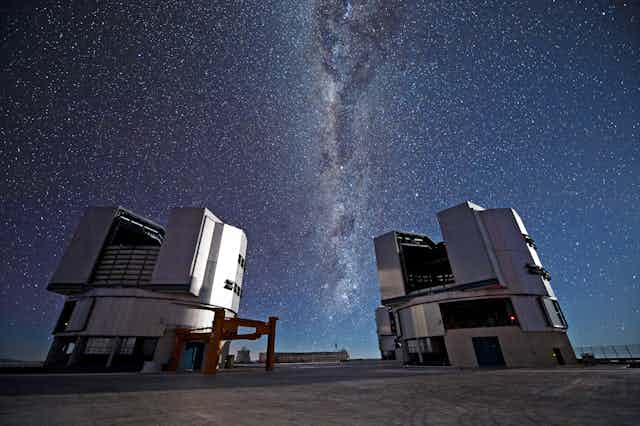After working its way into the Eurovision Song Contest, Australia is now joining with European efforts to explore the Universe and all its stars, planets and galaxies.
A new A$26.1 million commitment was made in last week’s federal budget for Australia to enter a ten-year strategic partnership with the European Southern Observatory (ESO). The commitment also includes ongoing funding, averaging A$12 million per year, to be provided until 2027-28.
This has long been sought by the Australian astronomy community. It will give us access to some of the world’s best optical telescopes, at the La Silla and Paranal observatories, high in the Atacama Desert, Chile.
In particular, the Paranal Observatory is home to the Very Large Telescope (VLT), a set of four 8.2-metre telescopes. Working separately these telescopes are impressive, but together they are amazing.

It is possible to combine the light of these telescopes (along with four auxillary 1.8-metre telescopes) via a series of connecting tunnels and mirrors. This brings a dramatic increase to the resolution of the images it creates.
The VLT can see objects 4 billion times fainter than the eye can see. At its highest resolution it could separate out the headlights of a car even if that car were as far away as the Moon.
Staying at the top
Australia well deserves its reputation as a leader in astronomical research.
Across the country, our astronomers are advancing our knowledge of the universe. From how the first stars formed in the early Universe to explaining how galaxies evolve and change, including our own Milky Way.
They’re searching for life on exoplanets, investigating dark matter and dark energy and are on the brink of seeing the Universe in a completely new way via gravitational waves.
But as identified in the Decadal Plan for Australian Astronomy (2016-2025), securing access to 8-metre-class optical telescopes, such as the VLT, was the biggest priority to maintain Australia’s current world standing.
A partnership with ESO delivers this goal and means that Australian astronomy will be strong on all fronts.
It firmly complements our involvement in two other multinational collaborations. One being the Square Kilometre Array (SKA), which will be the world’s largest radiotelescope and is in the process of being built here in Australia and in South Africa.
The other is the Giant Magellan Telescope (GMT), a US-led partnership in collaboration with Australia, Brazil, Korea and Chile (as host country) to build a next generation and gargantuan 25-metre telescope that is set to see its first light in 2021.
Eyes on the skies
Partnering with ESO allows Australia to build on its rich history of optical astronomy. Our largest optical telescope is the Anglo-Australian Telescope (AAT).
The AAT was built in 1974 and has a mirror 3.9m in diameter. It is located at Siding Spring Observatory near Coonabarabran in northern New South Wales.
Alongside the AAT sit a number of other highly productive telescopes, including the 2.3-metre Advanced Technology Telescope and the automated 1.3-metre SkyMapper telescope. Both are owned by the Australian National University (ANU), which runs the Siding Spring Observatory.

These telescopes continue to produce high-quality research, thanks to technological innovations and purpose built instruments that have changed the way astronomy is done.
The AAT in particular has established itself as a world pioneer in producing large surveys of galaxies that reveal the extent of the universe like never before.
Plans are underway for ANU to lead a coalition of Australian universities to operate the telescope until at least 2024.
Best of the best
Partnering with ESO provides Australian astronomers with access to exceptional telescopes in world-class observatories.
When it comes to astronomy, size matters. The bigger the telescope, the more light is collected, which allows you to see further and to see better.
Location is crucial too. The Hubble Space Telescope (HST) is quite a modest 2.4-metre telescope but it has the advantage of being above Earth’s atmosphere where the view is crystal clear.
For telescopes stuck on the ground the aim is to build them away from brightly lit populated areas and in regions that are high and dry. This means most of the murky atmosphere is below your telescope rather than above it and starlight can shine down without being heavily distorted or buffeted about.
ESO’s large, mountain-top telescopes will have our astronomers seeing further and seeing better than ever before.

World game
The ESO was formed in 1962 to provide European astronomers with access to pioneering telescopes and research facilities for observing the southern sky. Today, it consists of 16 member states including its founding members of Belgium, France, Germany, the Netherlands, Sweden and the host state Chile.

In this era of global of astronomy, it’s simply not possible for Australia to go it alone. Partnering with ESO opens up doors for Australia to build on its recognised scientific expertise.
It’s how we will develop the skills and collaborations needed to be relevant within the international community as it moves into the era of gargantuan telescopes in the next decade or so.
What’s more, the partnership plays to Australia’s recognised strength for developing astronomical instrumentation – the specialised contraptions that are added to a telescope so astronomers can probe the light from distant objects in meaningful ways.
Australian industry can be part of ESO’s competitive process to design and construct new facilities and instrumentation, creating significant opportunities to further promote Australia’s leadership in this area.
The strategic partnership will be negotiated formally with ESO over the coming months, with the aim to have everything in place by January 1, 2018. It’s invigorating for Australian astronomy to secure such a vital long-term plan to drive our science future.
Many thanks to Dr Mita Brierley of Australia Astronomy Limited for advice on this article.

